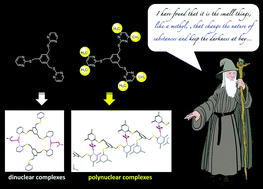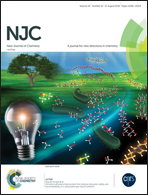Effects of methyl groups in a pyrimidine-based flexible ligand on the formation of silver(i) coordination networks†
Abstract
A novel flexible ligand with methyl substituted pyrimidine rings and thioether spacers has been synthesised and the corresponding 1 : 1 silver(I) adducts have been obtained by interaction with different silver(I) salts AgX (where X = NO3−, BF4−, ClO4−, CH3SO3−, CF3CO2−, and CF3CF2CF2CO2−). The X-ray single crystal structure determination of two of the new silver(I) adducts (X = NO3− and CF3CO2−) has proved the formation of coordination polymers with Ag(I) ions almost linearly coordinated to two nitrogen atoms of the pyrimidine rings of the multitopic ligand used. The linear coordination mode shown by the new flexible ligand is induced by the presence of the substituents on the pyrimidine rings, regardless of the type of the AgX salt used in the formation of the respective silver(I) derivatives. This observation represents a neat change in comparison to the already reported series of complexes with unsubstituted (and otherwise identical) ligands, in which dinuclear coordination units have been invariably obtained. Computational investigations have been performed with the aim of explaining such an observed change. A computational comparison of a known dinuclear complex and its related polymeric one has been detailed here and has allowed us to highlight the importance of the introduced substituents in changing the ligand interactions internally to their coordination units and among adjacent units in the solid phases.



 Please wait while we load your content...
Please wait while we load your content...